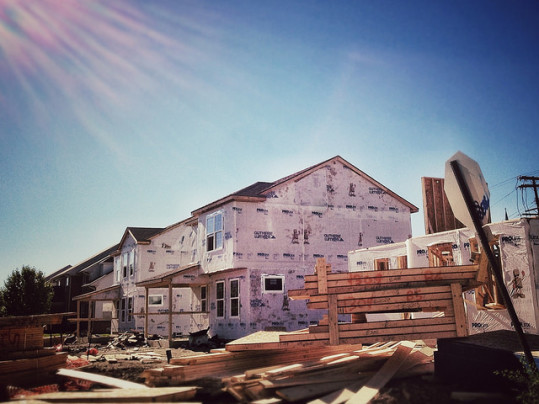The National Association Of Realtors’ most recent Pending Home Sales Index shows that the hot summer housing market has not deterred hopeful home buyers from looking for a house to buy. But though there is a high level of demand from buyers, supply issues continue to hold back sales numbers. In fact, the index found that the number of contracts to buy homes signed in May was essentially flat from the month before. Lawrence Yun, NAR’s chief economist, says sales are being hurt by low inventory but recent news that new home construction hit a 10-year high should be encouraging to prospective buyers. “Several would-be buyers this spring were kept out of the market because of supply and affordability constraints,” Yun said. “The healthy economy and job market should keep many of them actively looking to buy, and any rise in inventory would certainly help them find a home.” Regionally, results were mixed, with the Midwest, Northeast, and West all seeing modest increases, while the South saw a 3.5 percent drop. Pending home sales numbers are an important indicator, as they cover contract signings and not closings, which means they often foreshadow upcoming sales data. More here.
Archive for June 2018
Mortgage Rates Show Little Movement Last Week
According to the Mortgage Bankers Association’s Weekly Applications survey, average mortgage rates were up-and-down last week, with rates for 30-year fixed-rate mortgages with conforming loan balances relatively flat and mortgage rates for jumbo loans and those backed by the Federal Housing Administration down from the previous week. Joel Kan, an MBA economist, told CNBC rates are reacting to concerns over trade policy. “Concerns over trade between the US and China persisted last week,” Kan said. “And, these concerns outweighed positive news on housing starts and a generally bullish view on second quarter US growth.” In short, rates didn’t move much last week because positive economic news was balanced by concerns about future changes to trade policy. But despite unchanged rates, buyers retreated from the market, with the MBA’s survey finding a 6 percent decline in the number of Americans requesting applications for loans to buy homes. This could be due to affordability challenges or low inventory in some markets. Whatever the case, applications for loans to buy homes are now just 1 percent higher than they were at the same time last year. More here.
Homeowners See Big Gains On Home Sales
Home prices have been climbing for the past few years. And while that has presented affordability challenges for buyers in some markets, it’s also produced big gains for homeowners who’ve sold a home recently. Take, for example, new estimates showing that, nationally, the typical home seller, after living somewhere for eight years, made nearly $40,000 on their home sale. That’s good news for homeowners. And, in some markets, the sales gain is even higher. Homeowners in the Dallas-Fort Worth area saw a median sales gain of $56,297 after just 7.4 years and, in San Jose, sellers’ median price gain was nearly $300,000. But while that may be encouraging for anyone who hopes to sell soon, there is a flip side. Because many home sellers hope to use any money they make on their home sale as a down payment for their next home, the amount gained on a sale may not seem as significant, especially if you’re buying a home in the same market and price range. More here.
New Home Sales Spike 6.7% In May
A new home sales spike in the South drove overall sales 6.7 percent higher than the month before, according to new numbers from the U.S. Census Bureau and the Department of Housing and Urban Development. Sales were down or flat in the West, Northeast, and Midwest, but, in the South, were up nearly 18 percent from the previous month. Because of the surge, new home sales are now 14 percent higher than they were at the same time last year. Part of the reason for the improvement is the fact that there are fewer existing homes available for sale than is typical. With previously owned home inventory low, buyers are looking to new homes for additional choices. Fortunately for those buyers, the May report also showed that new home prices fell last month. In fact, the median sales price of new houses sold in May dropped 3.3 percent from one year earlier to $313,000. The average sales price was $368,500. Though still higher than prices for existing homes, new home prices are now at their lowest level in a year. More here.
How A Sellers’ Market Could Be Good For Buyers
The housing market is about supply and demand. When there are a lot of buyers and too few homes, prices and competition rise, making it a good time for homeowners who want to sell. When there are more homes than buyers, prices fall and bargains abound. In short, the market will usually favor either buyers or sellers. But, naturally, conditions that are good for buyers will lead to more buyers and vice versa. In other words, the pendulum swings back and forth. Which is why, a recent survey holds hope for buyers concerned about higher prices and increasing competition. The National Association of Realtors’ Housing Opportunities and Market Experience survey found that 75 percent of Americans think now is a good time to sell a home. And, if the perception that it’s a good time to sell leads to more homes being listed for sale, that will soon begin to moderate prices, making buying a more affordable proposition for the almost equal number of Americans who say they think now is a good time to buy. More here.
Typical Property Took 26 Days To Sell In May
Available homes continue to sell quickly with the typical property going under contract in less than a month, according to new numbers from the National Association of Realtors. The newly released data shows the average property sold in 26 days, which was unchanged from the month before. Lawrence Yun, NAR’s chief economist, says there are not enough homes to meet buyer demand and it’s causing available homes to sell quickly. “Inventory coming onto the market during this year’s spring buying season – as evidenced again by last month’s weak reading – was not even close to being enough to satisfy demand,” Yun said. “That is why home prices keep outpacing incomes and listings are going under contract in less than a month – and much faster – in many parts of the country.” Still, though there weren’t enough new listings last month to bring immediate relief, it’s an encouraging sign that total housing inventory was up nearly 3 percent in May. The improvement means there was a 4.1-month supply of available homes for sale at the current sales pace – a 6-month supply represents a healthy market. More here.
Steady Rates Lead To Boosted Mortgage Demand
A quiet week for interest rates led to a boost in mortgage demand, according to the most recent results of the Mortgage Bankers Association’s Weekly Applications Survey. Overall demand was up 5.1 percent from the previous week, which helped push the MBA’s purchase index 3 percent higher than the same week one year ago. The week’s results also showed a spike in refinance activity, reversing recent declines. Joel Kan, an MBA economist, told CNBC that there were offsetting concerns last week that led to the lack of movement in rates. “It was a mixed week for rates in MBA’s survey,” Kan said. “Treasury yields finished the week slightly higher as a hawkish statement from the FOMC and market jitters caused by trade concerns and other geopolitical uncertainty offset each other.” The MBA’s weekly survey has been conducted since 1990 and covers 75 percent of all retail residential mortgage applications. More here.







